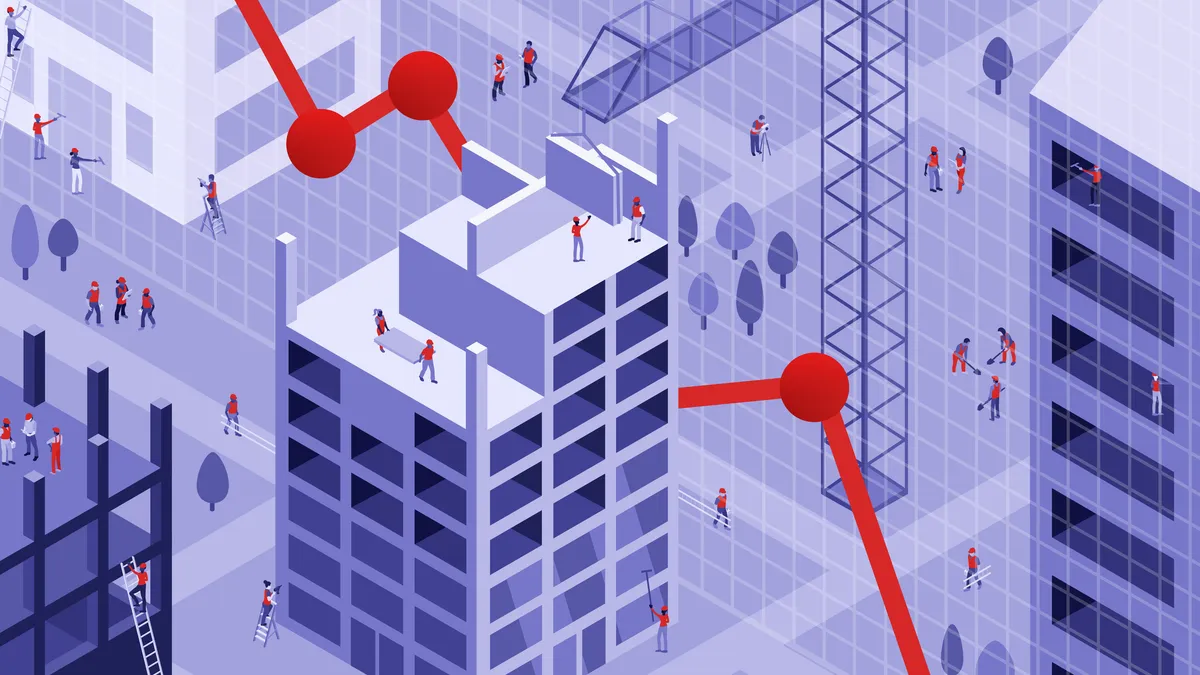This article is the first of a three-part series looking at how construction pros weather the ups and downs of a turbulent economy. Click here for part two and here for part three.
In his role as a staffing consultant for commercial and heavy industrial workers, Seth Sandler is in the front row of the construction employment rollercoaster.
“We normally see a decline or other recession indicators before many other industries," he told Construction Dive. "We also tend to see when the economy rebounds before many industries as our clients start placing orders again.”
These days, Sandler, CEO of Superior Skilled Trades in Rockledge, Florida, sees no such slowdown, and said the need for skilled tradespeople is at an all-time high.
“There is a massive deficit of tradespeople needed across the country, and not an adequate or even close to adequate supply to meet the demand,” he said.
Sandler is not alone in seeing an industry that's booming, despite warnings to the contrary. While economists, pundits and others have been pointing to a slowdown of the U.S. economy for months, many construction leaders are asking “What slowdown?”
In fact, there seems to be a disconnect between economists’ predictions and the fact that many builders say that business has never been better, said Ken Simonson, chief economist at the Associated General Contractors of America.
“The data are hard to reconcile,” he told Construction Dive.
The good news is that the data includes the monthly Job Openings and Labor Turnover Survey from the Bureau of Labor Statistics that has reported construction job openings at record levels for several months in a row. Similarly, a recent AGC survey found that 91% of respondents expect their companies will hire craft workers in the next 12 months either for expansion or replacement.
Another reason contractors may feel positive these days could relate to consumer-related economic trends, including increased consumer spending and confidence, low mortgage rates and low inflation. Simonson said that these indicators are expected to help buoy at least one sector of construction — home building — into the near future.
The bad news, Simonson said, is that recent construction spending numbers from the U.S. Census Bureau showed spending in the first seven months of 2019 was 2.1% lower than in January-July 2018 (without adjusting for inflation). In addition, the August Bureau of Labor Statistics employment report showed construction employment increased by 2.4% from August 2018 to August 2019, the smallest percentage increase in more than six years.
The reduced employment gains may reflect the difficulty contractors say they are having in finding qualified workers, Simonson said. For instance, 80% of respondents in AGC’s survey said it was hard to fill hourly craft positions and 57% said the same about salaried positions.
Lagging indicators
Another reason for the unclear economic signals is that although certain aspects of commercial building such as educational facilities and transportation terminals continue to move at a healthy clip, others are beginning to show some slippage, including multifamily, offices and warehouses, according to economist Robert Murray, vice president of Dodge Data & Analytics. This is especially true in certain geographical markets, including Seattle, Miami and San Francisco, according to Dodge data.
In addition, the industry generally lags in its response to economic changes and is traditionally among the last segments to enter a downturn and among the last to begin to recover, said Anirban Basu, chief economist of Associated Builders and Contractors.
“During the most recent economic downturn, nonresidential construction activity peaked in October 2008, fully 10 months into the 2007 to 2009 recession," he said. "The existence of backlog is the primary factor behind the lag."
Murray agreed, saying the generally strong levels of activity that contractors are experiencing are due to increased starts from two to three years ago.
"Both the planning and starts data are now showing either deceleration or modest declines, which will translate into reduced construction activity in a year or two," Murray said.
Nevertheless, Basu said he believes that U.S. construction is still expanding, but more slowly than a few months ago.
Other anxieties
Industry watchers' anxiety also partly relates to the uncertain forecast for U.S. businesses overall, making them more hesitant to invest in new structures or renovations of older ones. Some of the issues facing corporations include cost disadvantages, loss of export markets caused by U.S. trade policy and broader signs of a global economic slowdown, Simonson said.
With so many factors at play, he said, he "remains alert to signs of a possible extended slowdown or downturn in construction or some segments of it."





















